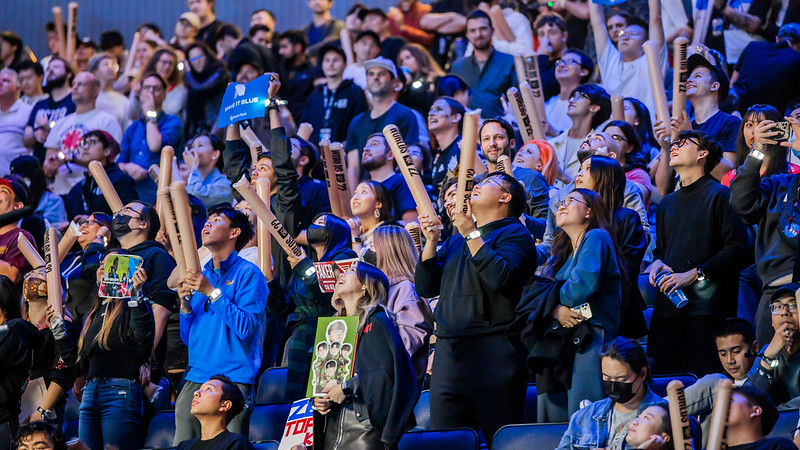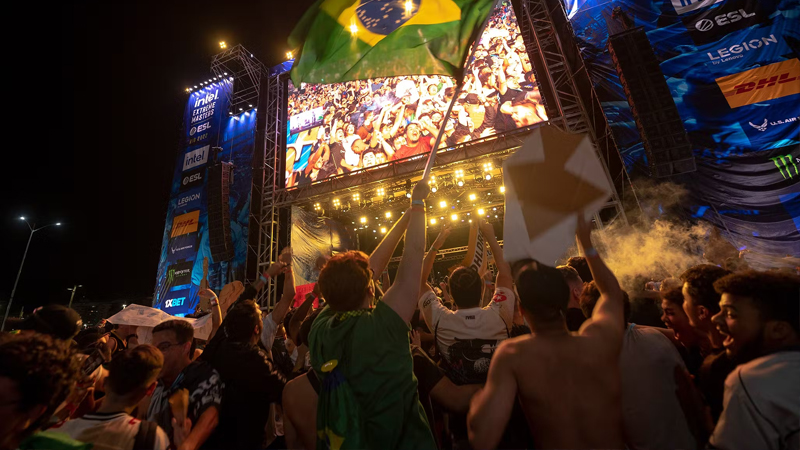Will the esports fans of today remain esports fans by 2040?
This depends on, among other things, the staying-power of esports titles. It also depends on the staying-power and general appeal of esports teams.
Both ought to be examined.

Photo by Colin Young-Wolff/Riot Games
Esports titles: Short shelf lives?
American investors see significant growth potential in European football, largely because support of clubs is sticky and reliable. This provides a foundation of guaranteed interest — and revenue — to build from. In traditional sport, a crucial thing that is taken for granted is the stickiness of the sports themselves. Football is in the public domain. It is untouchable.
In esports, the instability of a sport poses an existential threat. Not only are fans of teams not sticky; I would argue fans of games aren’t sticky either, at least long-term, because the games themselves are not guaranteed.
Game publishers will always favor profits over the health of an esport if the latter isn’t the money maker, which it never is and likely never will be. This means the interests of an esports scene will never be paramount.
What does this mean for the industry?
It means new game releases that play well competitively could drown out existing esports titles. In such a scenario, fan transfer from one game to another is not guaranteed.
Esports fandom is usually built within a single game. The esports industry underestimates how important this is. If fandom is built in a single game, what happens to fans if an esport dies?
Here’s what happens: When John Doe’s favourite esport dies, he might not find another to care about. Fan crossover between titles is not guaranteed. Existing fan data assumes those that are fans now will remain so. But in esports, there is probably more chance than in traditional sports of fans falling out of the data entirely.
What if a new esports title comes along that attracts a significant number of CS:GO’s top players? And if s1mple, NiKo and ZywOo migrate there? What happens to CS:GO? If it eventually dies, as a fan I then have to learn (and learn to care about) a new sport, new players, new storylines and more. I think it would be more likely that most fans never show the same level of interest in another esport or team again, even if it’s the best CSGO teams at the time.
Every new title released poses a threat to existing esports titles. The limited shelf life of esports titles has implications for the staying-power of teams, too.

IEM Rio 2022 had the “craziest” crowds in 2022
Esports teams have a long road to building a sustainable fan base
Cristiano Ronaldo, a Manchester United icon, just forced his way out of the club in disgrace. United fans did not follow Ronaldo and turn on the club — that would be sacrilege.
Esports is nowhere near traditional sport in this way. In fact, the exact opposite happened with OpTic Gaming in Call of Duty. #NotMyOpTic began to trend when Hector Rodriguez, founder of OpTic, left the org.
“That aint us,” Rodriguez tweeted about the newly formed OpTic Gaming LA franchise in the CDL, in a jab at the new OpTic owner, Immortals Gaming Club. Soon, players that were synonymous with the OpTic brand, like Scump, followed Rodriguez and joined NRG. Demand for the OpTic brand declined dramatically as CDL viewership, usually propped up by OpTic’s ‘Greenwall’ fanbase, was bad for OpTic matches and good for matches of the ‘new OpTic’: NRG’s Chicago Huntsmen.
In contrast, the Glazer family’s controversial ownership of Manchester United has led to repeated protests, but has not led to a mass exodus of fans. In sport, the team is sacred, in esports it is not.
Under normal circumstances, this would come with time. Manchester United has had almost 150 years to root itself in British culture. My argument is that esports does not operate under normal circumstances. When the sport itself changes frequently, it’s more likely that fans fall through the cracks along the way; as a team, you are not building one single fanbase in esports. You are building several.
How fan affinity towards esports titles and esports teams relate
Brands still dictate much of the viewership on a major event, as we recently saw at IEM Rio Major. The grand final between Outsiders and Heroic garnered a measly peak viewership of 1.1 million, according to Esports Charts — poor for the grand final of a CS:GO Major.
Contrast this to the all-time viewership record: the grand final at the PGL Stockholm Major last year, which reached a peak viewership of 2.7 million. Crucially, this was NAVI vs G2 Esports. Stalwart brands clearly move the needle, even in esports. (Although, it has to be said, this figure might have as much to do with s1mple’s presence, the best CSGO player ever, as it does with NAVI.)
However, what this proves is that people wanted to watch NAVI vs G2 in Counter-Strike. It does not show the strength of the NAVI or G2 brand across titles.
A Newzoo study from
Esports.net











